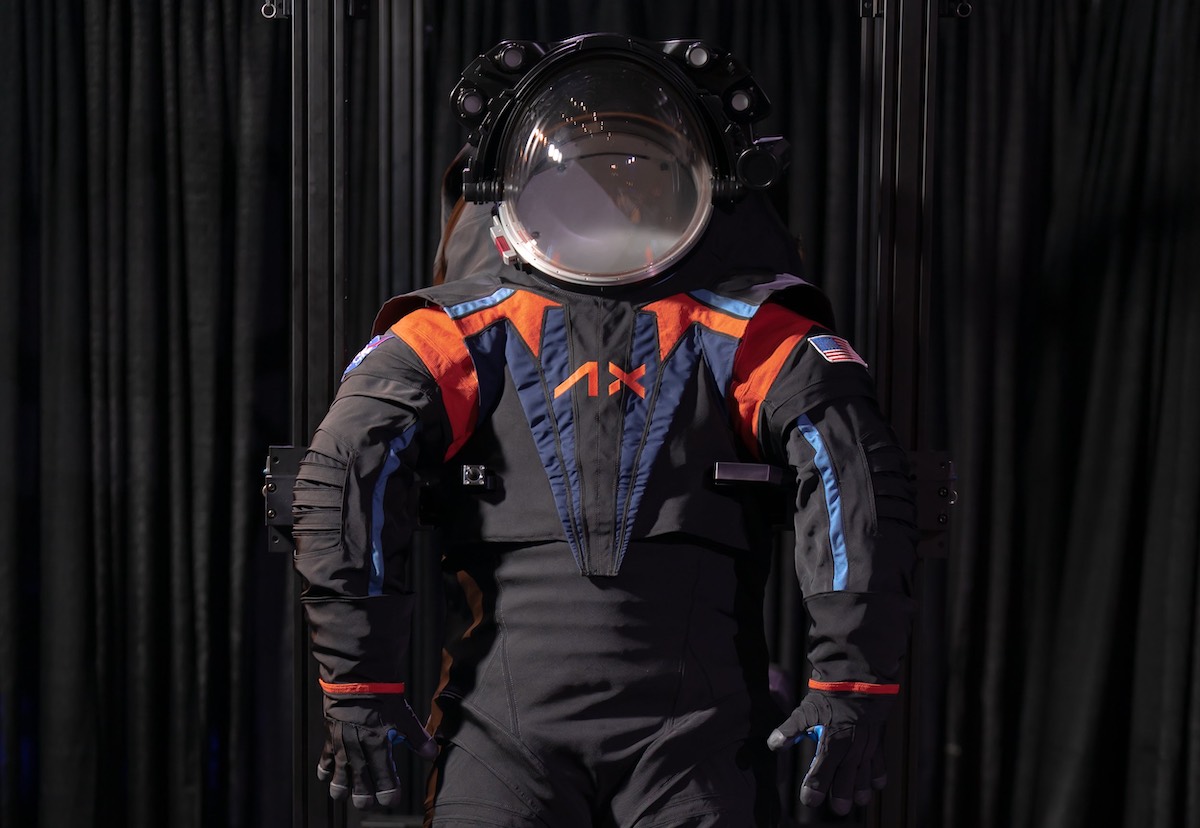Space News & Blog Articles
Axiom shows off Artemis moonsuits
 Axiom Space’s commercial spacesuit, designed for walking on the moon, is seen here under a black and orange cover. The suit’s outer layer will be mostly white during missions to the moon. Credit: Axiom Space
Axiom Space’s commercial spacesuit, designed for walking on the moon, is seen here under a black and orange cover. The suit’s outer layer will be mostly white during missions to the moon. Credit: Axiom Space
Houston-based Axiom Space on Wednesday showed off the new spacesuit NASA’s Artemis astronauts will wear when they return to the moon, a more flexible, dust resistant, insulated and radiation-shielded suit to protect them in the harsh environment near the lunar south pole.
“I think this suit is going to (be) a huge leap forward in terms of mobility and then just robustness to the lunar environment, the dust environment and things like that,” Russell Ralston, a spacesuit manager with Axiom Space, told CBS News.
“This suit will be much easier to walk in or to do a lot of the same tasks that they did back in Apollo and more … but to do it in a little bit easier way (and) not have to fight the suit so much.”
Axiom Space publicly unveiled the new suit at the Space Center Houston visitor complex just outside the Johnson Space Center. But it was a stand-in of sorts, with a black outer layer intended to conceal proprietary elements. The suit’s outer layer will be white for actual moonwalks to better reject heat when in sunlight.
In any case, the new suits are critical to the Artemis program. NASA launched the first Artemis mission last November, sending an unpiloted Orion capsule on a long, looping flight around the moon and back.
The Artemis 2 mission will send four astronauts on a shakedown trip around the moon in 2024 before the first woman and the next man land near the moon’s south pole aboard a SpaceX Starship spacecraft in the 2025-26 timeframe.
The Artemis 3 landing site, near frigid, permanently shadowed craters, poses unique challenges for spacesuit designers.
“Going into a permanently shaded region on the moon is something that’s never been done before by anything,” Ralston said. “So, the thermal challenges that come with putting something in an environment that cold, it’s like doing a spacewalk inside liquid nitrogen. How do you do that? That’s a hard problem.”
Along with providing air and carbon dioxide removal, the suits must protect astronauts from fine dust that can work its way into fabrics and abrade computer displays; provide a comfortable environment when working in ultra-low temperatures; and shield moonwalkers from solar radiation and even micrometeoroid impacts.
At the same time, moon suits must be light enough for extended forays on the surface, allowing astronauts the enhanced flexibility they’ll need to carry out exploration, making it easier to kneel, bend, turn and make the same sort of natural movements as a geologist collecting rocks on Earth.
An Axiom Space engineer wearing the new suit demonstrated its flexibility Wednesday, bending, turning, squatting and even kneeling. The moonsuit is designed to support moonwalks lasting up to eight hours or so and can accommodate both sexes and a wide range of sizes.
“The moon is definitely a hostile place, and the south pole is going to really be a challenge,” said Lara Kearney, manager of spacesuit and rover technology at the Johnson Space Center.
“So a lot of thermal requirements, we are really looking for improved mobility so that our astronauts can operate more efficiently and effectively than they were able to do many years ago when Apollo. And then of course, we have really stringent safety requirements. So (Axiom) certainly (has) their cut work cut out for them. But we are absolutely confident that they are going to be successful.”
One thing that hasn’t changed from the Apollo, shuttle and space station suits is waste management. Artemis astronauts, like all spacewalkers before them, will wear diapers during their moonwalks.
But overall, the new suits are a major step forward. NASA’s Apollo suits were designed in the 1960s and the agency’s current shuttle-heritage extravehicular mobility units, or EMUs, were not designed for planetary exploration.
“As NASA ventures back into exploration, the shuttle EMU suit’s not going to work,” Ralston said. “It’s not designed for exploration. It’s not designed to walk on the surface of a planetary body or anything like that.
“We needed a fresh start. And really, technology has come so far (since Apollo). It gives us an opportunity to make the suit safer, more reliable. … So, yeah, it was definitely time for a refresh.”
After years working on its own follow-on spacesuit designs, NASA, facing ballooning costs and technical challenges, turned suit development over to private industry. After a competition, Axiom Space won a $228.5 million “task order” under a $1.26 billion contract to provide suits for the Artemis 3 mission.
Collins Aerospace holds a $97 million NASA contract to develop a new suit for potential use outside the International Space Station. Both companies are expected to compete for follow-on spacewalk and moonwalk task orders.
When you subscribe to the SpaceZE News Feed, we will send you an e-mail when there are new updates on the site so you wouldn't miss them.

